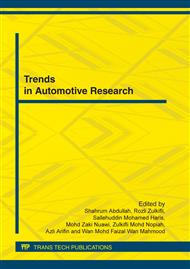p.73
p.78
p.83
p.88
p.93
p.98
p.104
p.109
p.114
Accurate Prediction of Springback in Forming of BIW Parts
Abstract:
The use of High Strength Steels (HSS) for automotive parts improves car performance in terms of structural strength and weight reduction. However it poses major challenges to manufacturing since HSS is prone to springback. Springback causes deviation in part geometry from its intended design thus giving problem to its subsequent assembly process. In this paper, three models for predicting springback were evaluated. First model is based on the Multiple Regression (MR) technique. Second model utilized Hill Orthotropic constitutive material model and the last model employed a neural network predictive model. All the models were evaluated by using tool surface and stamped part historical data that are obtained from three selected springback prone automotive BIW parts representing three different levels of springback severity namely high, medium and small. The results on the low springback part show that the neural network model outperforms the other approaches.
Info:
Periodical:
Pages:
93-97
Citation:
Online since:
April 2012
Keywords:
Price:
Сopyright:
© 2012 Trans Tech Publications Ltd. All Rights Reserved
Share:
Citation:


